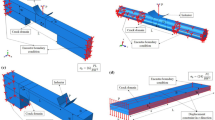Abstract
Previous work by the authors has indicated that crack behaviour in PMMA (and thus probably in other materials as well) shows a secondary dependence on the degree of in-plane stress biaxiality, in addition to its established primary dependence on K 1, the elastic stress intensity factor. Data published here shows the crack-length dependence of a parameter expressing the degree of stress biaxiality inherent to a number of standard specimen geometries. This should help to determine to what, if any, extent a given material's sensitivity to stress biaxiality is responsible for K 1-independent variations in crack behaviour between specimens.
Similar content being viewed by others
References
P.S. Leevers, L.E. Culver, and J.C. Radon, Engineering Fracture Mechanics 11 (1979) 487–498.
P.S. Leevers, J.C. Radon, and L.E. Culver, Polymer 17 (1976) 627–632.
P.S. Leevers, J.C. Radon, and L.E. Culver, Journal of the Mechanics and Physics of Solids 24 (1976) 381–395.
S.G. Larsson and A.J. Carlsson, Journal of the Mechanics and Physics of Solids 21 (1973) 263–278.
M.L. Williams, Journal of Applied Mechanics 24 (1957) 111–114.
D.P. Rooke and D.J. Cartwright, A Compendium of Stress Intensity Factors, HMSO, London (1976).
I.C. Howard, “A Method of Estimating Biaxial Fatigue Crack Growth Rates”. To be published in Fatigue of Engineering Materials and Structures.
B. Cotterell, International Journal of Fracture Mechanics 2 (1966) 526–533.
G. Urriolagoitia, “Directional Stability of Cracks Under Biaxial Stress”, Ph.D. Thesis, University of London (1976).
P.D. Ewing, J.L. Swedlow, and J.G. Williams, International Journal of Fracture 12 (1975) 85–93.
J.L. Swedlow, M.E. Karabin, and G.E. Maddux, in Fracture 1977, Proceedings International Conference of Fracture 4, Waterloo, Canada (1977) 103–109.
P.S. Leevers, “Crack Growth in Polymers under Complex Stress: a Fracture Mechanics Approach”, Ph.D. Thesis, University of London (1979).
H. Kitagawa and H. Ishikawa, in Fracture 1977, Proceedings International Conference on Fracture 4, Waterloo, Canada (1977) 111–119.
M. Isida, International Journal of Fracture Mechanics 7 (1971) 301–316.
B. Cotterell, International Journal of Fracture Mechanics 6 (1970) 189–192.
H.M. Westergaard, Journal of Applied Mechanics 6 (1937) A49–83.
G.R. Irwin, Journal of Applied Mechanics 24 (1957) 361–364.
G.C. Sih, International Journal of Fracture Mechanics 2 (1966) 628–631.
J. Eftis and H. Liebowitz, International Journal of Fracture Mechanics 8 (1972) 383–392.
C.F. Federson, in ASTM STP 410 (1966) 77.
L.P. Pook and R. Holmes, “Biaxial Fatigue Crack Growth Tests”, Presented at International Conference on Fatigue Testing and Design, City University, London (1976).
Author information
Authors and Affiliations
Rights and permissions
About this article
Cite this article
Leevers, P.S., Radon, J.C. Inherent stress biaxiality in various fracture specimen geometries. Int J Fract 19, 311–325 (1982). https://doi.org/10.1007/BF00012486
Received:
Revised:
Issue Date:
DOI: https://doi.org/10.1007/BF00012486




